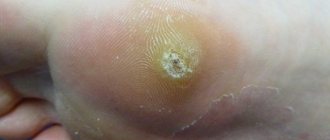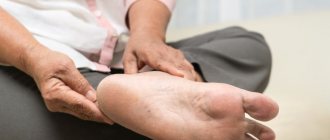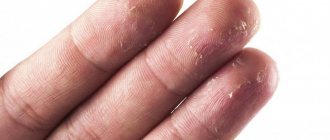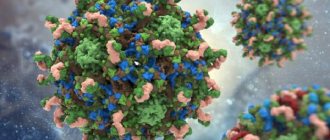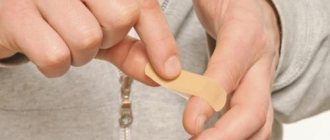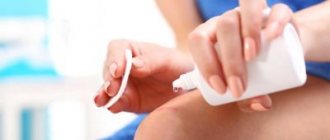What are warts and papillomas
Warts are formations on the skin and mucous membranes that look like nodules or papillae
This is the name for formations on the skin and mucous membranes that look like nodules or papillae. They are caused by the human papillomavirus (HPV), which has many different strains. They can also look different: the size of the growths varies from microscopic to two centimeters in length, color - from almost white to dark brown. It is believed that this virus is contained in the body of more than 70% of the world's population, but in most cases it does not manifest itself. Decreased immunity can lead to the appearance of warts and papillomas. The disease can also be triggered by stress or bad habits (smoking, drug use, alcohol).
Causes of plantar warts
Plantar warts are caused by the human papillomavirus (HPV). This is the same virus that causes warts on other parts of the body. Plantar warts often occur on the weight bearing points of the feet (that is, pressure points), such as the heels or balls of the toes. As a result of pressure, plantar warts can grow inward, forming a callus.
In most cases, plantar warts do not pose a health threat and usually do not require special treatment.
However, plantar warts can be uncomfortable or cause pain when walking. If home remedies for plantar warts are ineffective, you should see a doctor to have them removed. Unfortunately, it is almost impossible to determine how and when a virus infection occurred.
The human papillomavirus is everywhere. The main mode of transmission is from person to person, but you can become infected with HPV through contact with surfaces that have the virus on it. The warm, moist environment inside shoes or on the floor of a public pool, gym or shared shower room is particularly conducive to the spread of the virus.
Upon contact with a contaminated surface, the virus enters the skin, and the smallest scratch or cut on the fingers or toes is enough for the virus to enter the body. The incubation period of the virus ranges from several weeks to several months. After this period, one or more warts may appear on the body.
Fortunately, as you age, the likelihood of developing new warts decreases, due to the body's stronger immune response to the virus.
Is it possible to use folk remedies?
Recipe No. 1
Do you want to get rid of a wart, but don’t know how to treat this disease? A homemade ointment will help you remove unwanted growths. This remedy can be easily prepared even at home.
To prepare an ointment against warts, take 50 grams of fresh butter and two tablespoons of freshly squeezed watercress juice. Mix both components thoroughly until a homogeneous consistency is obtained and apply the ointment with massaging movements to the areas of the skin damaged by HPV.
Even the delicate skin of children can be cured of papillomas with such folk remedies, since the components of this ointment do not contain harmful substances.
Recipe No. 2
Alternative medicine offers many recipes that help get rid of warts on the toe at home
If a person has such a problem, then it is worth paying attention to the following recommendations of traditional healers:
- Throughout the day, lubricate the new growth with the juice of sour apples or onions several times.
- Once a day, apply fresh garlic paste to the affected area or simply treat it with juice.
- During the day, apply wood ash to the growth 2-3 times, which must first be diluted with vinegar, forming a paste.
- An ointment prepared from celandine juice and a small amount of Vaseline also removes warts.
- A compress of rowan berries should be applied daily.
- A remedy that is prepared in the following way helps a lot: put chopped onion pieces in a bowl and cover with regular salt. Wait until the mixture releases its juice and treat the warts on the feet with it.
- Once a day, treat the tumor with iodine, hydrogen peroxide or ammonia.
- Before going to bed, you can cauterize the growth on your foot or toe with a drop of vinegar.
Important addition: Conspiracy for warts. Types of conspiracies against warts
Traditional medicine recipes can be listed endlessly. But do not forget that some of them can negatively affect the skin, eliminating the wart but leaving burns. In any case, all non-traditional methods can get rid of pathology at home, but over a very long period of time.
It is necessary to distinguish between home removal methods and traditional ones, which mainly include herbal medicine.
There is no official medical evidence regarding the advisability of using them for treatment.
- Applications can be made from aloe pulp. To do this, the leaves are crushed into a pulp and applied to the growth for 10 days;
- rub raw potatoes into a paste and also apply to the wound;
- You can use celandine juice or ground garlic cloves mixed with baby cream to treat the surface.
Attempts to independently remove the growth, cut it off or bandage it with thread, lead to its proliferation and malignancy.
Origin of warts and transmission of infection
There are many types of human papillomavirus
Warts are nothing more than an ordinary papillomavirus that parasitizes the outer layers of human skin. According to modern data, several types of this virus are distinguished, each of which lives and reproduces primarily in its favorite places. For example, human papillomavirus (HPV) types 2 and 3 are more common on the skin between the fingers and on the hands. Such warts are usually called vulgar.
Other types of virus:
- HPV – types 1, 2 and 4, called plantar;
- HPV – type three, causes the appearance of flat warts;
- HPV types six and eleven cause the appearance of genital warts.
The human papillomavirus invades the epithelial cells of the skin, then penetrates the cell nucleus, where it multiplies and develops. According to various sources, from 10 to 20% of cases, the penetration of the virus into skin cells is accompanied by a change in its structure and the appearance of modified cancer cells. This is especially true for HPV types 6 and 11, which can cause cervical cancer. Usually people have increased resistance to this virus. But in cases of decreased immunity and resistance to viruses, anyone can become infected with this infection.
Mechanism of transmission of infection
The virus is transmitted primarily through contact.
When shaking hands, general use of household appliances, if a person has the slightest damage to the skin, the virus instantly penetrates through it and penetrates into skin cells
. (Common) vulgar and plantar warts are transmitted in this way. Genital warts, or, as they are commonly called, genital warts, are transmitted almost exclusively through sexual contact, because they are localized in the genital area in both men and women.
Prevention
They are aimed at complying with the following rules and procedures:
- maintain hygiene of the lower extremities;
- choose comfortable shoes that match your foot size;
- buy shoes made of high-quality material or genuine leather;
- women should avoid wearing high-heeled shoes every day and should take breaks;
- avoid constantly wearing sneakers or sneakers; shoes should have hard and stable soles;
- If you have orthopedic pathologies, you should wear special insoles.
You should also remember that you need to combat excessive sweating of the feet. Because excessive sweating increases the risk of developing fungal foot disease. And this is one of the reasons for the development of interdigital tumors.
Overweight people should choose comfortable shoes for everyday wear. After all, they have an increased load on their feet when walking.
If, nevertheless, growths between the fingers bother you regularly, then you should consult an orthopedic specialist. Perhaps they bother you precisely as a result of the incorrect position of the foot while walking.
When wearing tight shoes, a callus between the toes may appear as a result of squeezing the foot, or due to excessive friction of the shoe with the surface of the foot.
Particular attention should be paid to the material of the shoes
You should not save money and purchase shoes made from low-quality raw materials; this applies not only to the period of use of the shoes, but also to the impact on health. Shoes should allow the leather to “breathe.” Therefore, it is necessary to choose it from natural materials, for example, leather.
https://youtube.com/watch?v=ZphRaZTPrOc
- Prevention of external manifestations of HPV infection comes down to observing the rules of personal hygiene and culture of sexual relations.
- You cannot use other people’s items: towels, combs, shoes, gloves.
- Take care of yourself and your partner. Timely cured genital warts will prevent infection of a loved one and a child during childbirth.
- The Gardasil vaccine will help develop immunity not only to oncogenic viruses, but also to strains 6 and 11 that provoke the appearance of genital warts. It does not protect against common warts.
- keeping your feet clean;
- wearing shoes, socks and tights made from natural materials;
- carry out timely foot peeling;
- alternate high heels with flat platforms;
- choose casual shoes with hard soles;
- monitor body weight;
- choose shoes only by size;
- support the immune system;
- Monitor your diet and avoid vitamin deficiency.
Signs of plantar warts
The main symptom of plantar warts is the localization of pain and areas of increased sensitivity.
Obviously, warts are not the only type of growth that can appear on the soles or toes. How to distinguish warts from other skin formations?
The main symptom of plantar warts is the localization of pain and areas of increased sensitivity. If you experience pain or discomfort when you press on the sides of the growth (rather than when you press directly on the growth itself), it most likely is a wart.
Another characteristic feature is the appearance of the formation. Plantar warts are flat and rough, usually with distinct edges. They are flesh-colored or brown with a small black spot in the center (these are blood vessels).
Treatment of plantar warts
Plantar warts often do not require specific treatment. In most cases, warts go away on their own without any treatment within a few years. However, if they cause pain or spread throughout the entire sole, you should consult a doctor. It is much easier to treat a few small warts than a group of large warts.
Plantar warts can stubbornly resist treatment. Therefore, most treatments require patience, persistence and repetition.
People with diabetes, people with nerve damage in the legs or weakened immune systems should undergo treatment under the supervision of a doctor. As a rule, treatment begins with the least painful methods that have no side effects and do not leave scars. Scars on the soles of the feet can be painful and are usually permanent.
Removing warts on the sole
Currently, there are many effective and safe treatments for plantar warts. However, it should be noted that in some cases, reliable removal of warts is complicated by the fact that the human papillomavirus penetrates into the deepest layers of the epidermis (the basal layer).
Treatment of warts is necessary in cases where:
- the wart hurts;
- the wart bleeds;
- large wart;
- the color of the wart is uneven (for example, inclusions have appeared in it);
- there is rapid growth dynamics of the wart.
There are the following methods for removing plantar warts:
- cryodestruction;
- laser coagulation;
- electrocoagulation;
- radio wave surgery;
- surgical excision.
Cryodestruction
The cryodestruction method involves treating the wart with liquid nitrogen at a temperature of minus 196 degrees
This method involves treating the wart with liquid nitrogen at a temperature of minus 196 degrees. Cryodestruction is characterized by the fact that when a wart is frozen, the area of skin affected by viruses is destroyed, followed by stimulation of the body’s immune forces. However, it should be noted that if a wart appears and exists for up to six months, then the effectiveness of its removal is 84%. While the effectiveness of removing warts that have existed for more than six months is reduced to 39%.
The cryodestruction procedure can be performed:
- usually (liquid nitrogen is applied until a light halo with a diameter of two millimeters appears around the wart);
- aggressively (after a light halo appears around the wart, liquid nitrogen continues to be applied for another five to twenty seconds).
Research has shown that the aggressive method of freezing a wart is more effective than the conventional method, but the disadvantage is that it is more painful.
After removal of the wart, hyperemia (redness) of the skin is observed at the site of exposure, followed by the formation of edema. After a few hours, a blister forms on the affected area (may contain hemorrhagic or serous fluid), and approximately six to seven days after the blister dries, a crust forms in its place, which falls off on its own within two weeks.
After removing a wart, the following recommendations should be followed:
- the formed bubble at the site of the wart should not be opened;
- the affected area should not be covered with adhesive tape;
- It is recommended to bandage the site of exposure loosely, without tightening, with a sterile bandage to prevent mechanical damage and contamination of the affected area;
- It is recommended to treat the affected area with salicylic alcohol 2% twice a day;
- try to avoid getting water into the affected area.
| Advantages of the method | Disadvantages of the method |
| tissue healing occurs without scarring | if exposure to liquid nitrogen occurs superficially, then there is a high probability of relapse (re-formation) of the wart |
| the procedure is performed without the use of local anesthesia | After the procedure, local hypo- or hyperpigmentation may be observed |
| Removing a wart using this method takes one to two minutes | if deeper cauterization occurs, there is a risk of scarring |
Laser coagulation
When removing a wart, the laser beam simultaneously seals the vessels, thereby preventing the development of bleeding at the site of exposure
Removing warts using a laser beam is one of the most common treatment methods today. This method is characterized by layer-by-layer cauterization of the affected area, which allows you to control the depth of exposure. Also, when removing a wart, the laser beam simultaneously seals the blood vessels, thereby preventing the development of bleeding at the site of exposure.
The following laser coagulation methods exist:
- Carbon dioxide (CO2) laser. The wart is exposed to infrared light (wavelength 10,600 nm). The disadvantage of this treatment method is that tissue cauterization does not occur selectively, that is, there is a possibility of damage to healthy tissue. The effectiveness of removing plantar warts using a carbon dioxide laser is 70%.
- Erbium laser. This method is characterized by a shorter wavelength, 2940 nm, which significantly reduces the likelihood of scar formation after tissue epithelization. The effectiveness of this treatment method is 75%.
- Pulsed dye laser. This method is characterized by selective absorption of energy (wavelength is 586 nm) by oxygenated hemoglobin, which primarily destroys the dilated capillaries in the wart, as well as stimulates the immune system, which contributes to effective healing. The effectiveness of this treatment method is approximately 95%.
After laser treatment, a crust forms on the affected area, which disappears on its own within seven to ten days. It is not recommended to tear off the crust or lubricate it with anything (ointments, creams, alcohol solutions). Also, in the first few days after the procedure, you should avoid getting water on the treatment site.
| Advantages of the method | Disadvantages of the method |
| tissue healing occurs without scarring | The disadvantages of this method include only the high cost of the procedure |
| rapid tissue healing | |
| low risk of relapse (recurrence of the disease) | |
| practically does not affect healthy tissue |
Electrocoagulation
Electrocoagulation - exposure of the wart to high frequency current
The plantar wart is exposed to high frequency current. Cauterization of the affected area should be done under local anesthesia. Thanks to a coagulation loop applied to the affected area of the skin, an electric current is applied to the wart, which leads to its death. Also, the action of high temperatures leads to the soldering of blood vessels, which prevents the development of bleeding.
After the procedure, a dense crust forms at the site of exposure, which disappears on its own within ten days.
After removing a wart, the following recommendations should be followed:
- during the healing period, try to avoid contact with water or soap on the affected area of the skin;
- the formed crust should not be touched or torn off;
- In the first seven to ten days, it is recommended to treat the site of exposure with an antiseptic (for example, Lugol's solution, Iodinol) once or twice a day.
| Advantages of the method | Disadvantages of the method |
| affordable cost of the procedure | used for shallow warts of small size |
| prevents bleeding | when affecting the deep layers of the skin, a scar may remain after tissue healing |
| the procedure takes from a few seconds to one minute | When a wart is removed superficially, it may recur |
Radio wave surgery
Device for radio wave surgery
This treatment method involves using a special electrode that emits high-frequency radio waves (3.8 - 4.0 MHz). Exposing a plantar wart to high temperatures causes the cells infected with the papilloma virus to evaporate. Also, thanks to cauterization of blood vessels, the use of this method prevents the development of bleeding. After exposure, a crust forms on the affected area of the skin, which disappears on its own within seven to ten days.
During the healing period the following is contraindicated:
- in the first two days after the procedure, you should not wet the cauterization site;
- pick the crust for seven to ten days.
| Advantages of the method | Disadvantages of the method |
| when exposed to the affected area, healthy tissue is practically not affected | high cost of the procedure |
| Once the tissue has healed there is minimal risk of scarring | |
| after treatment, low risk of remission (two to five percent) |
Surgical excision
This method is characterized by removing the wart using a scalpel under local anesthesia. After excision of the affected area, sutures are applied, which are removed after seven to ten days.
| Advantages of the method | Disadvantages of the method |
| used to remove large warts | After the stitches are removed, scars may remain on the affected area |
| there is a risk of remission (disappearance of symptoms) of the wart |
General principles of caring for the affected area of skin after wart removal:
- if a crust forms, it should not be touched or torn off;
- limit the entry of water into the affected area;
- after removing a wart, the affected area should not be exposed to direct sunlight;
- Do not apply any cosmetics (for example, cream or lotion) to the affected area of the skin;
- for one to two months after wart removal, it is not recommended to visit public saunas, baths or swimming pools;
- After removing a wart, it is recommended to use vitamins A, C and E, as they promote rapid tissue regeneration (healing) and also stimulate the body's defenses.
Note: If complications arise after removing a wart (inflammation of the affected area, prolonged healing, scarring), you must consult your doctor as soon as possible.
For all treatment methods, contraindications to the procedure are:
- diabetes;
- the presence of malignant tumors;
- pregnancy;
- infectious and inflammatory diseases near the wart;
- exacerbation of herpes;
- increased body temperature;
- high blood pressure (above 140 per 100 millimeters of mercury).
Medical therapies
Modern possibilities allow you to quickly, painlessly and permanently get rid of unpleasant growths on the skin. For this purpose, in medical institutions the patient will be offered the following types of treatment:
- laser;
- electrocoagulation - burning with electric current;
- freezing with liquid nitrogen;
- removal by chemical action.
All these options do not cause pain during their implementation, which is important when treating a child, and they do not last long. After this, the doctor must prescribe the patient to take immunostimulants.
It is the decrease in the body’s defenses that leads to a new wave of activation of the papilloma virus, and if you ignore this doctor’s instructions, new formations on the skin of the legs cannot be avoided. Warts often appear on the big toe and appear there again and again after unsuccessful removal attempts.
Regarding medications, we cannot fail to mention special bottles with liquid nitrogen, with which you can freeze a wart on your finger yourself at home
It is important to emphasize the need to strictly follow the instructions, otherwise the desired result will not be achieved. In addition, such drugs are contraindicated for children under 4 years of age.
A one-time cryodestruction removes the formation within 10 days. If this does not happen, the removal procedure is repeated 14 days after the first one.
When visiting a clinic or beauty salon for treatment, ointments and creams with the following active ingredients are prescribed:
- salicylic acid;
- resorcinol;
- dermatol;
- solcoderm;
- trichloroacetic acid.
Ready-made ointments are used for treatment:
- oxolinic;
- riodoxol;
- bonaftone;
- colchamine;
- Tebrofenova.
Unconventional means
Along with the medicinal approach, people actively use folk recipes. This treatment at home often gives excellent results. If warts appear on your fingers, it is advisable to get rid of them as soon as possible. The classic option is to use the juice of the celandine plant. Fresh or ready-made pharmaceutical extract is applied to the area of the skin of the legs damaged by the growth every day until the infected cells die completely. Aloe, calendula, and tea tree oil have a similar effect.
Warts often appear between the fingers - in this place it is very inconvenient to remove them; drops of medicine constantly flow down and do not stay in the right place. In this case, ointments and applications covered with adhesive tape will help:
1. Cut a clove of garlic very thinly, apply it to the area, avoiding getting it on healthy skin, and fix it.
2. Soak a small onion in vinegar for about 2 hours, then tie it to the sore spot overnight. The procedure is not pleasant, but by repeating it several times in a row before going to bed, you can ensure that the formation comes out from the roots.
3. Place chalk under the adhesive plaster, rubbing it additionally onto the wart. You can't get this place wet.
4. Treatment by applying a cut aloe leaf at night is effective. Moreover, the older the plant, the stronger its properties.
5. Finely grate a clove of garlic and a piece of onion, and stick a small amount to the formation with an adhesive plaster.
[poller_master poll_id=»1" extra_class=»opros»]
It is very important to treat the problem comprehensively. Warts on the legs will go away without waiting for radical measures if, together with pharmaceutical products:
- use traditional medicine recipes, alternate them;
- constantly carry out hygienic procedures, while the wart should always be kept dry, and should not be allowed to steam in closed shoes;
- support the immune system in every way and try to improve the body’s defenses, treat all diseases in a timely manner. Garlic, onion, lemon, as well as a number of pharmacy vitamin complexes and echinacea tincture will help with this.
Therefore, if we consider that a wart is an infectious skin lesion caused by the papilloma virus, and it can sometimes be very difficult to remove it, it is important to always monitor the condition of the skin and health in general, do everything to avoid provoking the appearance of such a growth, and apply preventive measures . But, if the problem has already touched and it is necessary to get rid of it, gentle treatment at home comes to the rescue in the form of medications and traditional medicine tips that can be offered to the child
If they do not produce results, there are several methods for instant removal.
